Arrhenius Equation for Calculating Viscosity in Assessing the Dilution Level of Lubricating Oil with Diesel Oil—A Case Study of SAE 30 and SAE 40 Grade Marine Lubricating Oils
Abstract
1. Introduction
- Accumulation of pollutants (wear products of interacting machine elements, products of the combustion process, dust, and dust present in the air);
- The oil being diluted with other oils, grease, or coolants;
- Oil aging due to oxidation and thermal decomposition of components;
- Depletion of additives that modify the properties of the oil (chemical reactions);
- Infection of the oil with protozoa, bacteria, fungi, and viruses.
2. Materials and Methods
3. Results and Discussion
4. Conclusions
Author Contributions
Funding
Data Availability Statement
Acknowledgments
Conflicts of Interest
Abbreviations
| A | designation of the liquid that is a component of the mixture |
| API | American Petroleum Institute |
| ASTM | American Society for Testing and Materials |
| B | designation of the liquid that is a component of the mixture |
| C | actual mass concentration of diesel oil in the mixture with lubricating oil |
| CD | API quality class of lubricating oils for self-ignition engines |
| Cest | estimated mass concentration of diesel oil in the mixture with lubricating oil |
| CF | API quality class of lubricating oils for self-ignition engines |
| DO | diesel oil |
| DMX | marine distillate fuels category according to the ISO 8217:2017 standard |
| ESR | electron spin resonance |
| GC | gas chromatography |
| GC-MS | gas chromatography–mass spectrometry |
| FTIR | Fourier-transform infrared spectroscopy |
| ISO | International Organization for Standardization |
| LO | lubricating oil |
| JPI | Japan Petroleum Institute |
| NMR | nuclear magnetic resonance |
| SAE | Society of Automotive Engineers |
| SAE 30, SAE 40 | viscosity grades of lubricating oils according to the SAE J300-2021 standard |
| SAW | surface acoustic wave |
| t | measurement temperature |
| UV | ultraviolet |
| xA | mole fraction of liquid A |
| xB | mole fraction of liquid B |
| xDO | mole fraction of diesel oil |
| xFLO | mole fraction of lubricating oil |
| xmDO | mass fraction of diesel oil |
| xmFLO | mass fraction of lubricating oil |
| δC | absolute error in estimating the mass concentration of diesel oil in the mixture with lubricating oil |
| δη | absolute error in estimating the dynamic viscosity of the mixture |
| ηA, ηB | dynamic viscosity of liquids A, B |
| ηDO | dynamic viscosity of diesel oil |
| ηFLO | dynamic viscosity of fresh lubricating oil |
| ηmix | dynamic viscosity of the mixture of liquids A and B |
| ηULO | calculated dynamic viscosity of lubricating oil (mixture of lubricating and diesel oils) |
Appendix A. Data Tables
| Diesel Oil Concentration in the Mixture C (% m/m) | 0 | 1 | 2 | 5 | 10 | 20 | 50 | 100 | |
|---|---|---|---|---|---|---|---|---|---|
| Measured dynamic viscosity of the mixture ηreal (mPa s) | |||||||||
| Measurement temperature t (°C) | 40 | 92.69 | 86.45 | 85.17 | 72.71 | 52.21 | 31.52 | 9.41 | 2.37 |
| 50 | 57.95 | 51.89 | 51.39 | 47.05 | 34.54 | 21.54 | 7.13 | 1.98 | |
| 60 | 36.26 | 33.09 | 32.77 | 28.90 | 22.72 | 15.29 | 5.43 | 1.66 | |
| 70 | 24.73 | 22.74 | 22.52 | 20.04 | 16.09 | 11.21 | 4.32 | 1.41 | |
| 80 | 17.61 | 16.44 | 16.25 | 15.05 | 11.85 | 8.50 | 3.50 | 1.23 | |
| 90 | 12.77 | 12.16 | 12.04 | 11.27 | 9.01 | 6.63 | 2.89 | 1.08 | |
| 100 | 9.91 | 9.33 | 9.25 | 8.69 | 7.04 | 5.32 | 2.44 | 0.96 | |
| Diesel Oil Concentration in the Mixture C (% m/m) | 0 | 1 | 2 | 5 | 10 | 20 | 50 | 100 | |
|---|---|---|---|---|---|---|---|---|---|
| Measured dynamic viscosity of the mixture ηreal (mPa s) | |||||||||
| Measurement temperature t (°C) | 40 | 141.19 | 139.35 | 131.42 | 109.02 | 68.92 | 43.75 | 11.26 | 2.37 |
| 50 | 86.00 | 80.95 | 76.69 | 64.56 | 44.32 | 29.37 | 8.44 | 1.98 | |
| 60 | 52.04 | 49.72 | 47.37 | 40.52 | 29.42 | 20.33 | 6.36 | 1.66 | |
| 70 | 34.50 | 33.21 | 31.70 | 27.56 | 20.49 | 14.60 | 5.01 | 1.41 | |
| 80 | 23.99 | 23.40 | 22.46 | 19.56 | 14.80 | 10.85 | 4.05 | 1.23 | |
| 90 | 17.20 | 16.88 | 16.23 | 14.29 | 11.11 | 8.37 | 3.35 | 1.08 | |
| 100 | 12.87 | 12.72 | 12.25 | 10.87 | 8.58 | 6.58 | 2.79 | 0.96 | |
| Diesel Oil Concentration in the Mixture C (% m/m) | 0 | 1 | 2 | 5 | 10 | 20 | 50 | 100 | |
|---|---|---|---|---|---|---|---|---|---|
| Estimated dynamic viscosity of the mixture ηULO (mPa s) | |||||||||
| Measurement temperature t (°C) | 40 | 92.69 | 89.35 | 86.13 | 77.16 | 64.24 | 44.52 | 14.82 | 2.37 |
| 50 | 57.95 | 56.02 | 54.16 | 48.95 | 41.35 | 29.50 | 10.72 | 1.98 | |
| 60 | 36.26 | 35.16 | 34.09 | 31.08 | 26.64 | 19.57 | 7.76 | 1.66 | |
| 70 | 24.73 | 24.03 | 23.35 | 21.43 | 18.57 | 13.95 | 5.91 | 1.41 | |
| 80 | 17.61 | 17.15 | 16.70 | 15.42 | 13.49 | 10.34 | 4.65 | 1.23 | |
| 90 | 12.77 | 12.45 | 12.15 | 11.28 | 9.97 | 7.79 | 3.71 | 1.08 | |
| 100 | 9.91 | 9.68 | 9.46 | 8.81 | 7.84 | 6.21 | 3.08 | 0.96 | |
| Diesel Oil Concentration in the Mixture C (% m/m) | 0 | 1 | 2 | 5 | 10 | 20 | 50 | 100 | |
|---|---|---|---|---|---|---|---|---|---|
| Estimated dynamic viscosity of the mixture ηULO (mPa s) | |||||||||
| Measurement temperature t (°C) | 40 | 141.19 | 135.54 | 130.11 | 115.10 | 93.83 | 62.35 | 18.30 | 2.37 |
| 50 | 86.00 | 82.82 | 79.76 | 71.23 | 58.99 | 40.46 | 13.06 | 1.98 | |
| 60 | 52.04 | 50.28 | 48.58 | 43.81 | 36.88 | 26.13 | 9.30 | 1.66 | |
| 70 | 34.50 | 33.41 | 32.36 | 29.40 | 25.06 | 18.20 | 6.97 | 1.41 | |
| 80 | 23.99 | 23.29 | 22.61 | 20.68 | 17.82 | 13.23 | 5.42 | 1.23 | |
| 90 | 17.20 | 16.73 | 16.28 | 14.98 | 13.04 | 9.88 | 4.31 | 1.08 | |
| 100 | 12.87 | 12.54 | 12.22 | 11.30 | 9.92 | 7.65 | 3.51 | 0.96 | |
| Diesel Oil Concentration in the Mixture C (% m/m) | 0 | 1 | 2 | 5 | 10 | 20 | 50 | 100 | |
|---|---|---|---|---|---|---|---|---|---|
| Absolute error in estimating dynamic viscosity of the mixture δη (mPa s) | |||||||||
| Measurement temperature t (°C) | 40 | 0.00 | 2.90 | 0.96 | 4.45 | 12.03 | 13.01 | 5.42 | 0.00 |
| 50 | 0.00 | 4.13 | 2.77 | 1.90 | 6.81 | 7.97 | 3.58 | 0.00 | |
| 60 | 0.00 | 2.07 | 1.32 | 2.17 | 3.92 | 4.28 | 2.33 | 0.00 | |
| 70 | 0.00 | 1.29 | 0.84 | 1.39 | 2.48 | 2.74 | 1.59 | 0.00 | |
| 80 | 0.00 | 0.71 | 0.45 | 0.37 | 1.64 | 1.84 | 1.15 | 0.00 | |
| 90 | 0.00 | 0.29 | 0.11 | 0.01 | 0.96 | 1.16 | 0.81 | 0.00 | |
| 100 | 0.00 | 0.35 | 0.21 | 0.13 | 0.80 | 0.89 | 0.64 | 0.00 | |
| Diesel Oil Concentration in the Mixture C (% m/m) | 0 | 1 | 2 | 5 | 10 | 20 | 50 | 100 | |
|---|---|---|---|---|---|---|---|---|---|
| Absolute error in estimating dynamic viscosity of the mixture δη (mPa s) | |||||||||
| Measurement temperature t (°C) | 40 | 0.00 | 3.81 | 1.31 | 6.08 | 24.91 | 18.60 | 7.03 | 0.00 |
| 50 | 0.00 | 1.87 | 3.06 | 6.67 | 14.67 | 11.09 | 4.62 | 0.00 | |
| 60 | 0.00 | 0.56 | 1.21 | 3.29 | 7.46 | 5.80 | 2.93 | 0.00 | |
| 70 | 0.00 | 0.20 | 0.66 | 1.84 | 4.57 | 3.61 | 1.96 | 0.00 | |
| 80 | 0.00 | 0.11 | 0.15 | 1.11 | 3.02 | 2.38 | 1.37 | 0.00 | |
| 90 | 0.00 | 0.14 | 0.04 | 0.69 | 1.93 | 1.52 | 0.96 | 0.00 | |
| 100 | 0.00 | 0.19 | 0.04 | 0.43 | 1.34 | 1.07 | 0.71 | 0.00 | |
| Diesel Oil Concentration in the Mixture C (% m/m) | 0 | 1 | 2 | 5 | 10 | 20 | 50 | 100 | |
|---|---|---|---|---|---|---|---|---|---|
| Estimated diesel oil concentration in the mixture Cest (% m/m) | |||||||||
| Measurement temperature t (°C) | 40 | 0.00 | 1.90 | 2.31 | 6.62 | 15.66 | 29.42 | 62.40 | 100.00 |
| 50 | 0.00 | 3.27 | 3.56 | 6.17 | 15.33 | 29.32 | 62.06 | 100.00 | |
| 60 | 0.00 | 2.97 | 3.28 | 7.35 | 15.16 | 28.00 | 61.55 | 100.00 | |
| 70 | 0.00 | 2.93 | 3.27 | 7.33 | 15.01 | 27.63 | 60.93 | 100.00 | |
| 80 | 0.00 | 2.59 | 3.03 | 5.91 | 14.86 | 27.35 | 60.63 | 100.00 | |
| 90 | 0.00 | 1.97 | 2.37 | 5.04 | 14.10 | 26.51 | 60.02 | 100.00 | |
| 100 | 0.00 | 2.58 | 2.94 | 5.63 | 14.63 | 26.58 | 59.94 | 100.00 | |
| Diesel Oil Concentration in the Mixture C (% m/m) | 0 | 1 | 2 | 5 | 10 | 20 | 50 | 100 | |
|---|---|---|---|---|---|---|---|---|---|
| Estimated diesel oil concentration in the mixture Cest (% m/m) | |||||||||
| Measurement temperature t (°C) | 40 | 0.00 | 0.32 | 1.75 | 6.33 | 17.55 | 28.67 | 61.87 | 100.00 |
| 50 | 0.00 | 1.61 | 3.04 | 7.61 | 17.59 | 28.50 | 61.57 | 100.00 | |
| 60 | 0.00 | 1.33 | 2.73 | 7.26 | 16.56 | 27.28 | 61.00 | 100.00 | |
| 70 | 0.00 | 1.19 | 2.65 | 7.02 | 16.29 | 26.90 | 60.32 | 100.00 | |
| 80 | 0.00 | 0.84 | 2.22 | 6.86 | 16.25 | 26.66 | 59.81 | 100.00 | |
| 90 | 0.00 | 0.69 | 2.10 | 6.69 | 15.79 | 26.02 | 59.10 | 100.00 | |
| 100 | 0.00 | 0.43 | 1.88 | 6.50 | 15.57 | 25.79 | 58.75 | 100.00 | |
| Diesel Oil Concentration in the Mixture C (% m/m) | 0 | 1 | 2 | 5 | 10 | 20 | 50 | 100 | |
|---|---|---|---|---|---|---|---|---|---|
| Absolute error in estimating dynamic viscosity of the mixture δC (%) | |||||||||
| Measurement temperature t (°C) | 40 | 0.00 | 0.90 | 0.31 | 1.62 | 5.66 | 9.42 | 12.40 | 0.00 |
| 50 | 0.00 | 2.27 | 1.56 | 1.17 | 5.33 | 9.32 | 12.06 | 0.00 | |
| 60 | 0.00 | 1.97 | 1.28 | 2.35 | 5.16 | 8.00 | 11.55 | 0.00 | |
| 70 | 0.00 | 1.93 | 1.27 | 2.33 | 5.01 | 7.63 | 10.93 | 0.00 | |
| 80 | 0.00 | 1.59 | 1.03 | 0.91 | 4.86 | 7.35 | 10.63 | 0.00 | |
| 90 | 0.00 | 0.97 | 0.37 | 0.04 | 4.10 | 6.51 | 10.02 | 0.00 | |
| 100 | 0.00 | 1.58 | 0.94 | 0.63 | 4.63 | 6.58 | 9.94 | 0.00 | |
| Diesel Oil Concentration in the Mixture C (% m/m) | 0 | 1 | 2 | 5 | 10 | 20 | 50 | 100 | |
|---|---|---|---|---|---|---|---|---|---|
| Absolute error in estimating dynamic viscosity of the mixture δC (%) | |||||||||
| Measurement temperature t (°C) | 40 | 0.00 | 0.68 | 0.25 | 1.33 | 7.55 | 8.67 | 11.87 | 0.00 |
| 50 | 0.00 | 0.61 | 1.04 | 2.61 | 7.59 | 8.50 | 11.57 | 0.00 | |
| 60 | 0.00 | 0.33 | 0.73 | 2.26 | 6.56 | 7.28 | 11.00 | 0.00 | |
| 70 | 0.00 | 0.19 | 0.65 | 2.02 | 6.29 | 6.90 | 10.32 | 0.00 | |
| 80 | 0.00 | 0.16 | 0.22 | 1.86 | 6.25 | 6.66 | 9.81 | 0.00 | |
| 90 | 0.00 | 0.31 | 0.10 | 1.69 | 5.79 | 6.02 | 9.10 | 0.00 | |
| 100 | 0.00 | 0.57 | 0.12 | 1.50 | 5.57 | 5.79 | 8.75 | 0.00 | |
Appendix B. Derivation of Mathematical Models
Appendix B.1. Viscosity of the Lubricating Oil and Diesel Oil Mixture
Appendix B.2. Mass Concentration of Diesel Oil in a Mixture with Lubricating Oil
References
- Chybowski, L.; Wiaterek, D.; Jakubowski, A. The Impact of Marine Engine Component Failures upon an Explosion in the Starting Air Manifold. J. Mar. Sci. Eng. 2022, 10, 1850. [Google Scholar] [CrossRef]
- Brünnet, H.; Reppekus, D.; Theobald, M.; Kornatz, G. Formation and avoidance of crankcase explosions in large oil, dual-fuel and gas engines. In Proceedings of the 5th Rostock Large Engine Symposium, Rostock, Germany, 13–14 September 2018; pp. 280–297. [Google Scholar]
- Nozdrzykowski, K.; Adamczak, S.; Grządziel, Z.; Dunaj, P. The Effect of Deflections and Elastic Deformations on Geometrical Deviation and Shape Profile Measurements of Large Crankshafts with Uncontrolled Supports. Sensors 2020, 20, 5714. [Google Scholar] [CrossRef]
- Chybowska, D.; Chybowski, L.; Myśków, J.; Manerowski, J. Identification of the Most Important Events to the Occurrence of a Disaster Using Maritime Examples. Sustainability 2023, 15, 10613. [Google Scholar] [CrossRef]
- Borkowski, T.; Kowalak, P.; Myśków, J. Vessel main propulsion engine performance evaluation. J. KONES 2012, 19, 53–60. [Google Scholar] [CrossRef]
- Kaminski, P. Experimental Investigation into the Effects of Fuel Dilution on the Change in Chemical Properties of Lubricating Oil Used in Fuel Injection Pump of Pielstick PA4 V185 Marine Diesel Engine. Lubricants 2022, 10, 162. [Google Scholar] [CrossRef]
- Chybowski, L.; Kowalak, P.; Dąbrowski, P. Assessment of the Impact of Lubricating Oil Contamination by Biodiesel on Trunk Piston Engine Reliability. Energies 2023, 16, 5056. [Google Scholar] [CrossRef]
- Encyclopedia of Lubricants and Lubrication; Mang, T., Ed.; Springer: Berlin/Heidelberg, Germany, 2014; ISBN 978-3-642-22646-5. [Google Scholar]
- Krupowies, J. Badania Zmian Właściwości Oleju Obiegowego Okrętowych Silników Pomocniczych (Research on Property Changes in the Circulating Oils of Ship Auxiliary Engines); Wyższa Szkoła Morska w Szczecinie: Szczecin, Poland, 2002. [Google Scholar]
- Szczepanek, M. Biofuels as an alternative fuel for West Pomeranian fishing fleet. J. Phys. Conf. Ser. 2019, 1172, 012074. [Google Scholar] [CrossRef]
- Kowalak, P.; Myśków, J.; Tuński, T.; Bykowski, D.; Borkowski, T. A method for assessing of ship fuel system failures resulting from fuel changeover imposed by environmental requirements. Eksploat. Niezawodn.—Maint. Reliab. 2021, 23, 619–626. [Google Scholar] [CrossRef]
- Chybowski, L.; Myśków, J.; Kowalak, P. Analysis of fuel properties in the context of the causes of three marine auxiliary engines failure—A case study. Eng. Fail. Anal. 2023, 150, 107362. [Google Scholar] [CrossRef]
- Chybowski, L. Study of the Relationship between the Level of Lubricating Oil Contamination with Distillation Fuel and the Risk of Explosion in the Crankcase of a Marine Trunk Type Engine. Energies 2023, 16, 683. [Google Scholar] [CrossRef]
- Rattenbury, N. Crankcase explsions—A historical review—Where we are today. In Crankcase Explosions; IMAREST: London, UK, 2002; pp. 3–13. [Google Scholar]
- Chybowski, L.; Szczepanek, M.; Gawdzińska, K.; Klyus, O. Particles Morphology of Mechanically Generated Oil Mist Mixtures of SAE 40 Grade Lubricating Oil with Diesel Oil in the Context of Explosion Risk in the Crankcase of a Marine Engine. Energies 2023, 16, 3915. [Google Scholar] [CrossRef]
- Montaud, A.; Fabriek, W.P.; Vrolijk, D.J.E.; Lim, K.C.; Dunn, A. Contamination of marine crankcase lubricants by raw fuel: Consequences, and methods of detection. J. Inst. Energy 1998, 71, 2–11. [Google Scholar]
- Wolak, A.; Zając, G.; Żółty, M. Changes of properties of engine oils diluted with diesel oil under real operating conditions. Combust. Engines 2018, 173, 34–40. [Google Scholar] [CrossRef]
- Hu, T.; Teng, H.; Luo, X.; Lu, C.; Luo, J. Influence of Fuel Dilution of Crankcase Oil on Ignitability of Oil Particles in a Highly Boosted Gasoline Direct Injection Engine. SAE Tech. Pap. 2015, 1, 2811. [Google Scholar] [CrossRef]
- Critchley, L. Fuel Dilution in Engine Oil—How It Happens and What It Leads to. Available online: https://www.azom.com/article.aspx?ArticleID=16891 (accessed on 16 June 2022).
- Herdzik, J. Problems of propulsion systems and main engines choice for offshore support vessels. Zesz. Nauk. Akad. Morskiej w Szczecinie Sci. J. Marit. Univ. Szczec. 2013, 36, 45–50. [Google Scholar]
- Bejger, A.; Drzewieniecki, J.B. A New Method of Identifying the Limit Condition of Injection Pump Wear in Self-Ignition Engines. Energies 2020, 13, 1601. [Google Scholar] [CrossRef]
- Technomics International Case Study—Fuel Dilution of Engine Oil in Locomotives. Available online: https://www.techenomics.net/case-studies/fuel-dilution-engine-oil/ (accessed on 8 June 2022).
- Castrol Oil Contamination Identification. A List of the Top Offenders. Available online: https://www.castrol.com/content/dam/castrol/country-sites/en_us/united-states/home/hd-focus-newsletter/labcheck-oil-contamination-infographic.pdf (accessed on 7 June 2023).
- AMETEK Spectro Scientific Measuring Fuel Dilution in Lubricating Oil. Available online: https://www.azom.com/article.aspx?ArticleID=12880 (accessed on 14 June 2022).
- ASTM D3524-14(2020); Standard Test Method for Diesel Fuel Diluent in Used Diesel Engine Oils by Gas Chromatography. ASTM International: West Conshohocken, PA, USA, 2020.
- ASTM D3525-20; Standard Test Method for Gasoline Fuel Dilution in Used Gasoline Engine Oils by Wide-Bore Capillary Gas Chromatography. ASTM International: West Conshohocken, PA, USA, 2020.
- ASTM D7593-14; Standard Test Method for Determination of Fuel Dilution for In-Service Engine Oils by Gas Chromatography. ASTM International: West Conshohocken, PA, USA, 2023.
- JPI-5S-23-2017; Engine Oils—Determination of Diesel Fuel Diluent. The Japan Petroleum Institute: Tokyo, Japan, 2017.
- JPI-5S-24-2017; Determination of Gasoline Diluent. The Japan Petroleum Institute: Tokyo, Japan, 2017.
- ASTM E2412-10(2018); Standard Practice for Condition Monitoring of In-Service Lubricants by Trend Analysis Using Fourier Transform Infrared (FT-IR) Spectrometry. ASTM International: West Conshohocken, PA, USA, 2018.
- ASTM D8004-15; Standard Test Method for Fuel Dilution of In-Service Lubricants Using Surface Acoustic Wave Sensing. ASTM International: West Conshohocken, PA, USA, 2023.
- CEC L-94-10; Determination of Asphaltenes in Used Engine Oil. CEC (Coordinating European Council): London, UK, 2010.
- Shimadzu Gas Chromatografy. Testing the Dilution Rate of Diesel in Engine Oil in Accordance with ASTM D3524. Available online: https://www.shimadzu.com/an/sites/shimadzu.com.an/files/pim/pim_document_file/applications/application_note/10855/jpc119015.pdf (accessed on 22 July 2023).
- CEC L-47-M-97; Recommended Standard Methods for Analysis of Used Oil from Large Diesel Engines. CEC (Coordinating European Council): London, UK, 1997.
- CEC M-13-T-92; Recommended Standard Methods for Used Engine Oil Analyses. CEC (Coordinating European Council): London, UK, 1992.
- CEC M-12-T-91; Representative Sampling In-service of Marine Crankcase Lubricants. CEC (Coordinating European Council): London, UK, 1991.
- Sejkorová, M.; Hurtová, I.; Jilek, P.; Novák, M.; Voltr, O. Study of the Effect of Physicochemical Degradation and Contamination of Motor Oils on Their Lubricity. Coatings 2021, 11, 60. [Google Scholar] [CrossRef]
- Ning, J.; Lei, Y.; Hu, H.; Gai, C. A Comprehensive Review of Surface Acoustic Wave-Enabled Acoustic Droplet Ejection Technology and Its Applications. Micromachines 2023, 14, 1543. [Google Scholar] [CrossRef]
- Krupowies, J. Badania i Ocena Zmian Właściwości Użytkowych Olejów Urządzeń Okrętowych (Research and Assessment of Changes in Functional Properties of Marine Oils); Maritime University of Szczecin: Szczecin, Poland, 2009. [Google Scholar]
- Kendall, J.; Monroe, K.P. The viscosity of liquids. II. The viscosity composition curve for ideal liquid mixtures. J. Am. Chem. Soc. 1917, 39, 1787–1802. [Google Scholar] [CrossRef]
- Zhmund, B. Viscosity Blending Equations. Eur. Lubr. Ind. Mag. 2014, 121, 24–29. [Google Scholar]
- ASTM D7152-11(2016)e1; Standard Practice for Calculating Viscosity of a Blend of Petroleum Products. ASTM International: West Conshohocken, PA, USA, 2020.
- Arrhenius, S. Über die innere Reibung verdünnter wässeriger Lösungen. Z. Phys. Chemie 1887, 1U, 285–298. [Google Scholar] [CrossRef]
- Grunberg, L.; Nissan, A.H. The energies of vaporisation, viscosity and cohesion and the structure of liquids. Trans. Faraday Soc. 1949, 45, 125. [Google Scholar] [CrossRef]
- Oswal, S.; Desai, H. Studies of viscosity and excess molar volume of binary mixtures. 1. Propylamine + 1-alkanol mixtures at 303.15 and 313.15 K. Fluid Phase Equilib. 1998, 149, 359–376. [Google Scholar] [CrossRef]
- McAllister, R.A. The viscosity of liquid mixtures. AIChE J. 1960, 6, 427–431. [Google Scholar] [CrossRef]
- Grunberg, L.; Nissan, A.H. Mixture Law for Viscosity. Nature 1949, 164, 799–800. [Google Scholar] [CrossRef] [PubMed]
- Taylor, R.I. Fuel-Lubricant Interactions: Critical Review of Recent Work. Lubricants 2021, 9, 92. [Google Scholar] [CrossRef]
- SAE J300-2021; Engine Oil Viscosity Classification. SAE International (Society of Automotive Engineers): Warrendale, PA, USA, 2021.
- ISO 8217:2017; Petroleum Products—Fuels (class F)—Specifications of Marine Fuels. 6th ed. ISO (International Organization for Standardization): Geneva, Switzerland, 2017.
- Oleje-Smary AGIP Cladium 120 SAE 30 CD. Available online: https://oleje-smary.pl/pl/p/AGIP-Cladium-120-SAE-30-CD-20-litrow/186 (accessed on 12 July 2022).
- Oleje-Smary AGIP Cladium 120 SAE 40 CD. Available online: https://oleje-smary.pl/pl/p/AGIP-Cladium-120-SAE-40-CD-20-litrow/188 (accessed on 12 July 2022).
- PKN Orlen, S.A. ZN-ORLEN-5—Przetwory Naftowe. Olej Napędowy EFECTA DIESEL; PKN Orlen S.A.: Płock, Poland, 2019. [Google Scholar]
- API Engine Oil Guide. Available online: https://www.api.org/~/media/files/certification/engine-oil-diesel/publications/mom_guide_english_2013.pdf (accessed on 26 February 2023).
- ITALCO (Far East) Pte Ltd. Product Data Sheet—eni Cladium 120 (series); ITALCO: Singapore, 2017. [Google Scholar]
- PN-EN ISO 3104:2021-03; Petroleum Products—Transparent and Opaque Liquids - Determination of Kinematic Viscosity and Calculation of Dynamic Viscosity. PKN (Polski Komitet Normalizacyjny): Warszawa, Poland, 2021.
- Anton Paar ASTM D 2270—Viscosity Index (VI) from 40 °C and 100 °C. Available online: https://wiki.anton-paar.com/pl-pl/wskaznik-lepkosci-vi-od-40c-i-100c-astm-d2270/ (accessed on 7 September 2022).
- ISO 2719:2016; Determination of Flash Point—Pensky-Martens Closed Cup Method. 4th ed. ISO (International Organization for Standardization): Geneva, Switzerland, 2016.
- PKN Orlen, S.A. Olej Napędowy. Ecodiesel Ultra B,D,F, Olej Napędowy Arktyczny Klasy 2, Efecta Diesel B,D,F, Verva on B,D,F; PKN Orlen S.A.: Płock, Poland, 2021. [Google Scholar]
- DIN 51794:2003-05; Testing of Mineral Oil Hydrocarbons—Determination of Ignition Temperature. German Institute for Standardisation (Deutsches Institut für Normung): Berlin, Germany, 2003.
- ISO/DIS 12185:2002; Crude Petroleum, Petroleum Products and Related Products—Determination of Density—Oscillating U-Tube Method. ISO: Geneva, Switzerland, 2002.
- Chybowski, L. Lube Oil—Diesel Oil Mixes—Dataset; Version 3, Mendeley Data. 2022. Available online: https://data.mendeley.com/datasets/scbx3h2bmf/3 (accessed on 28 October 2023).
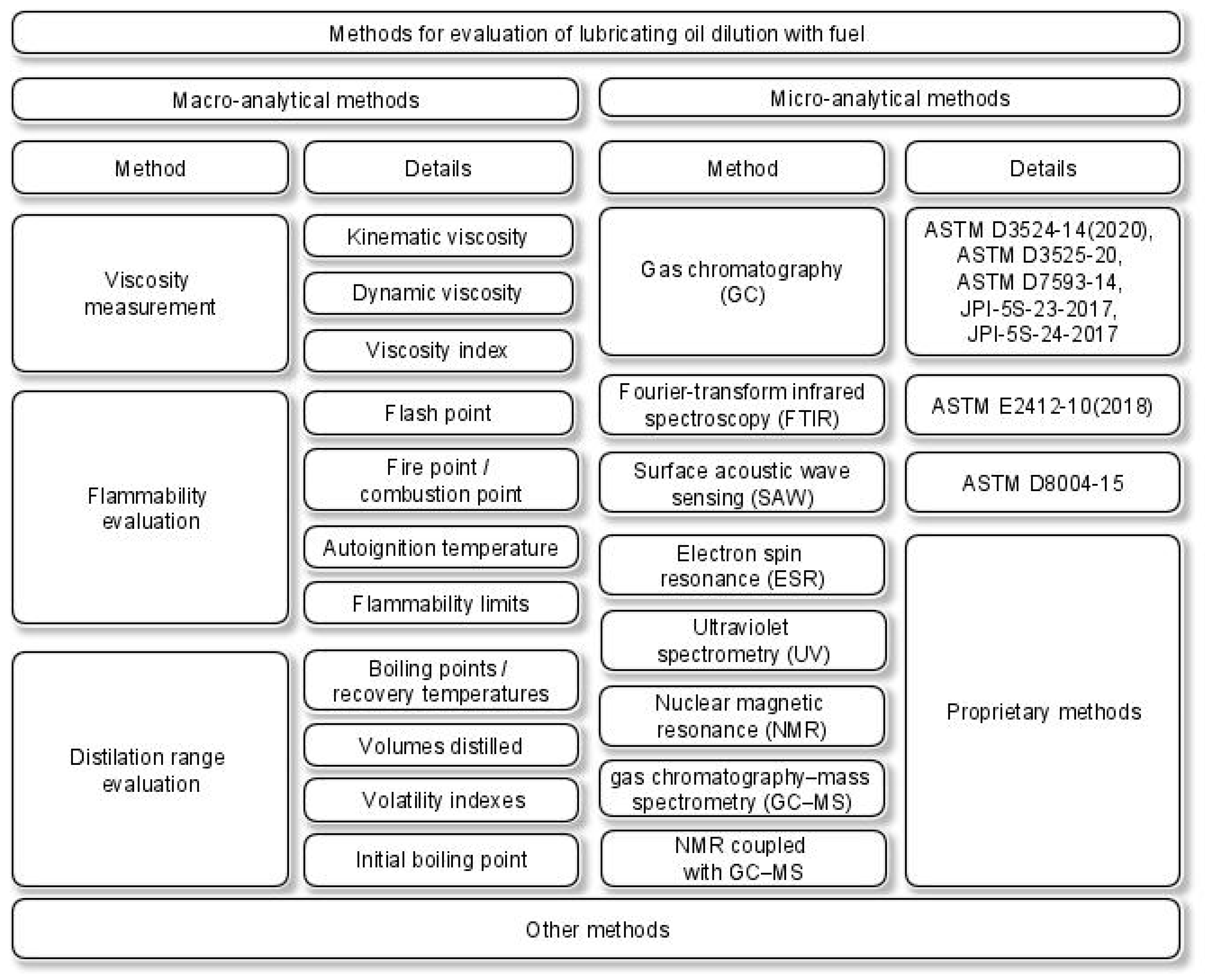
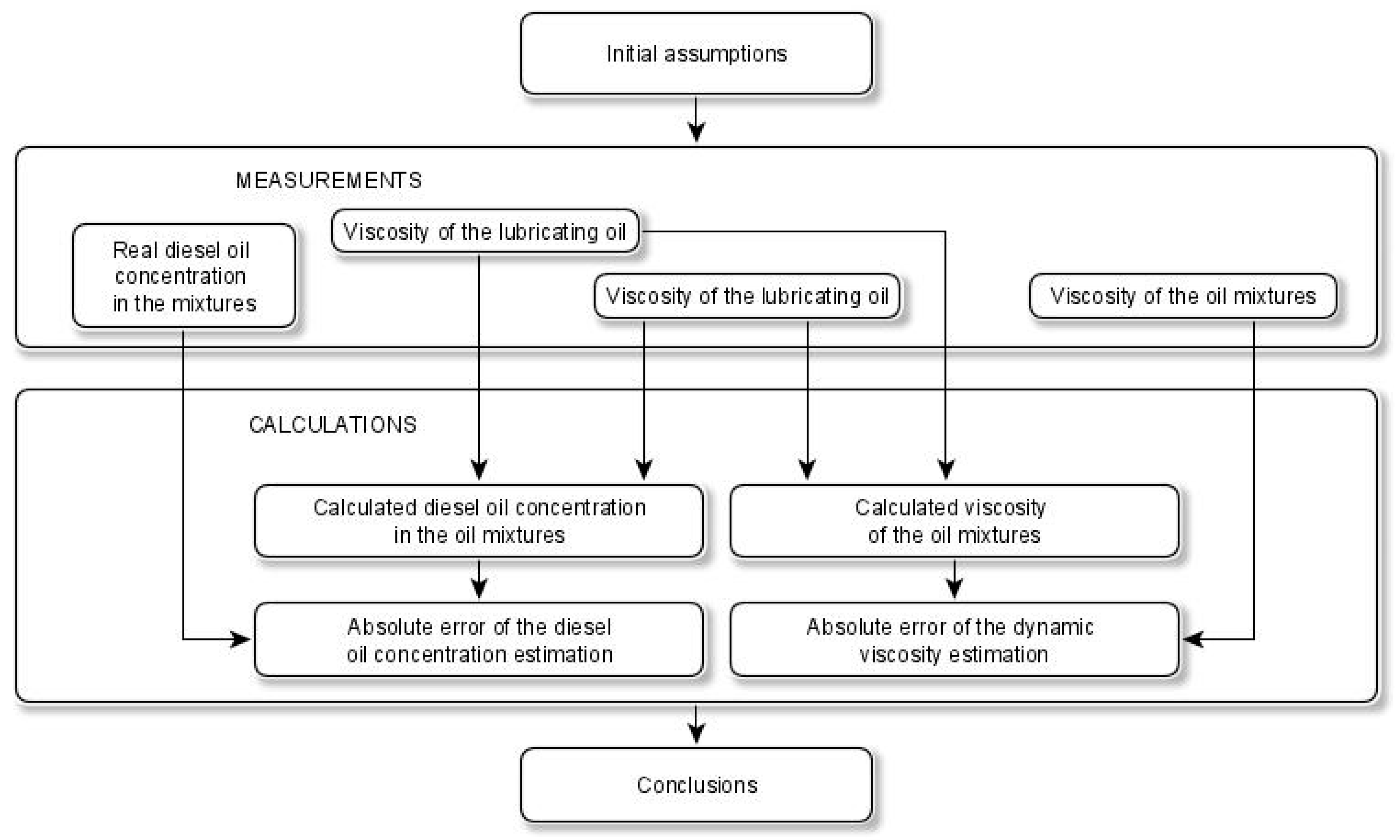
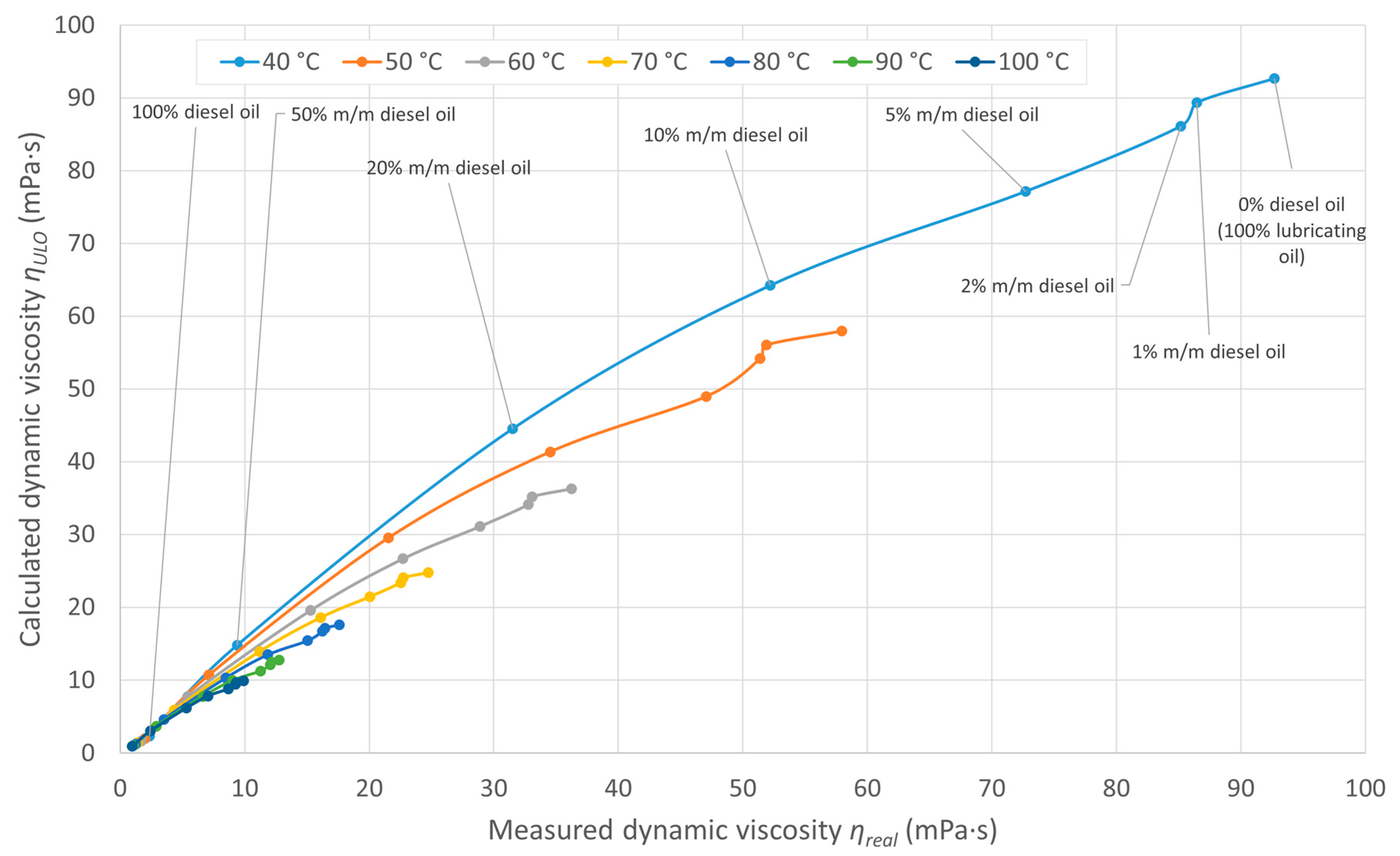

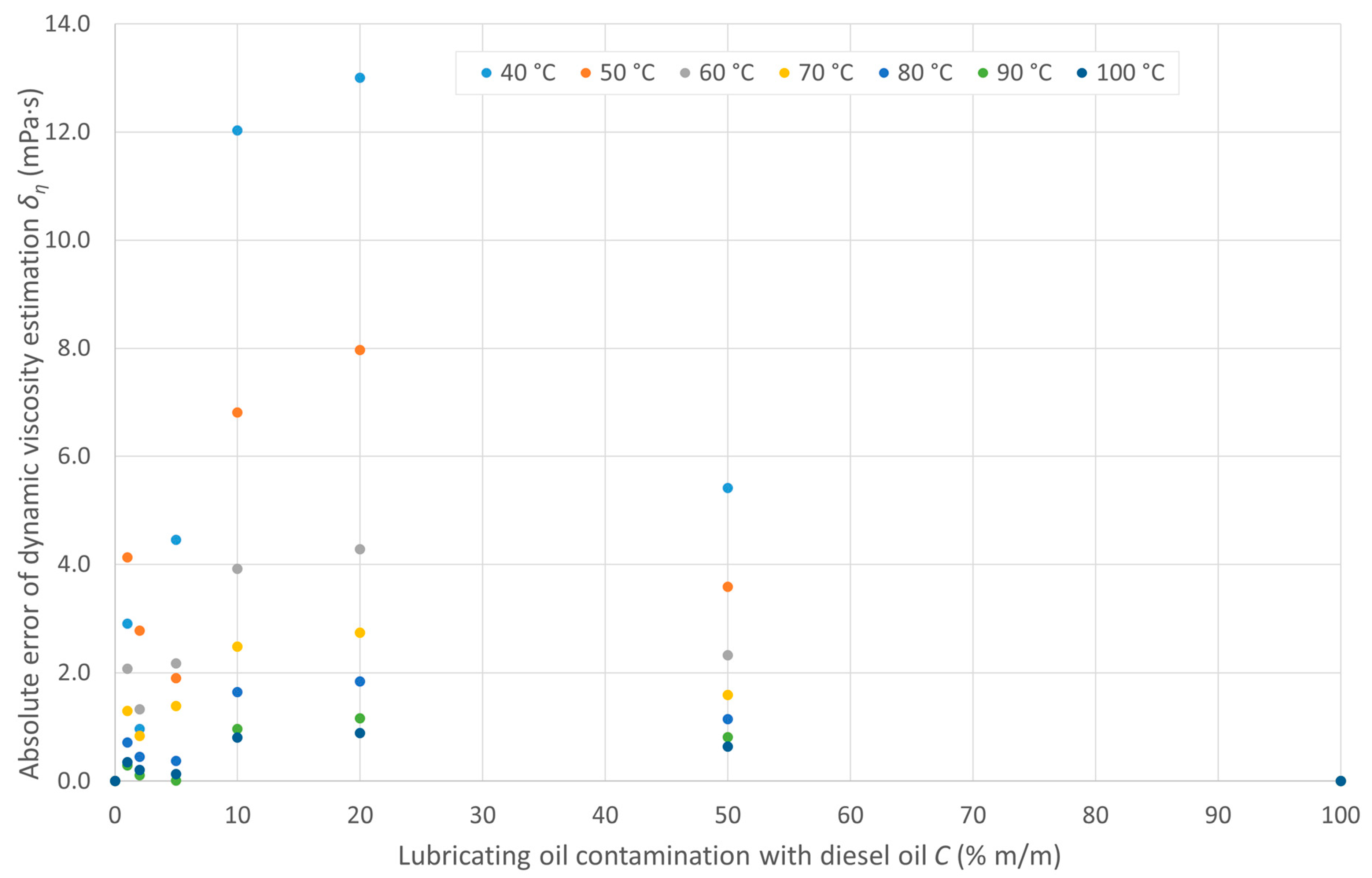
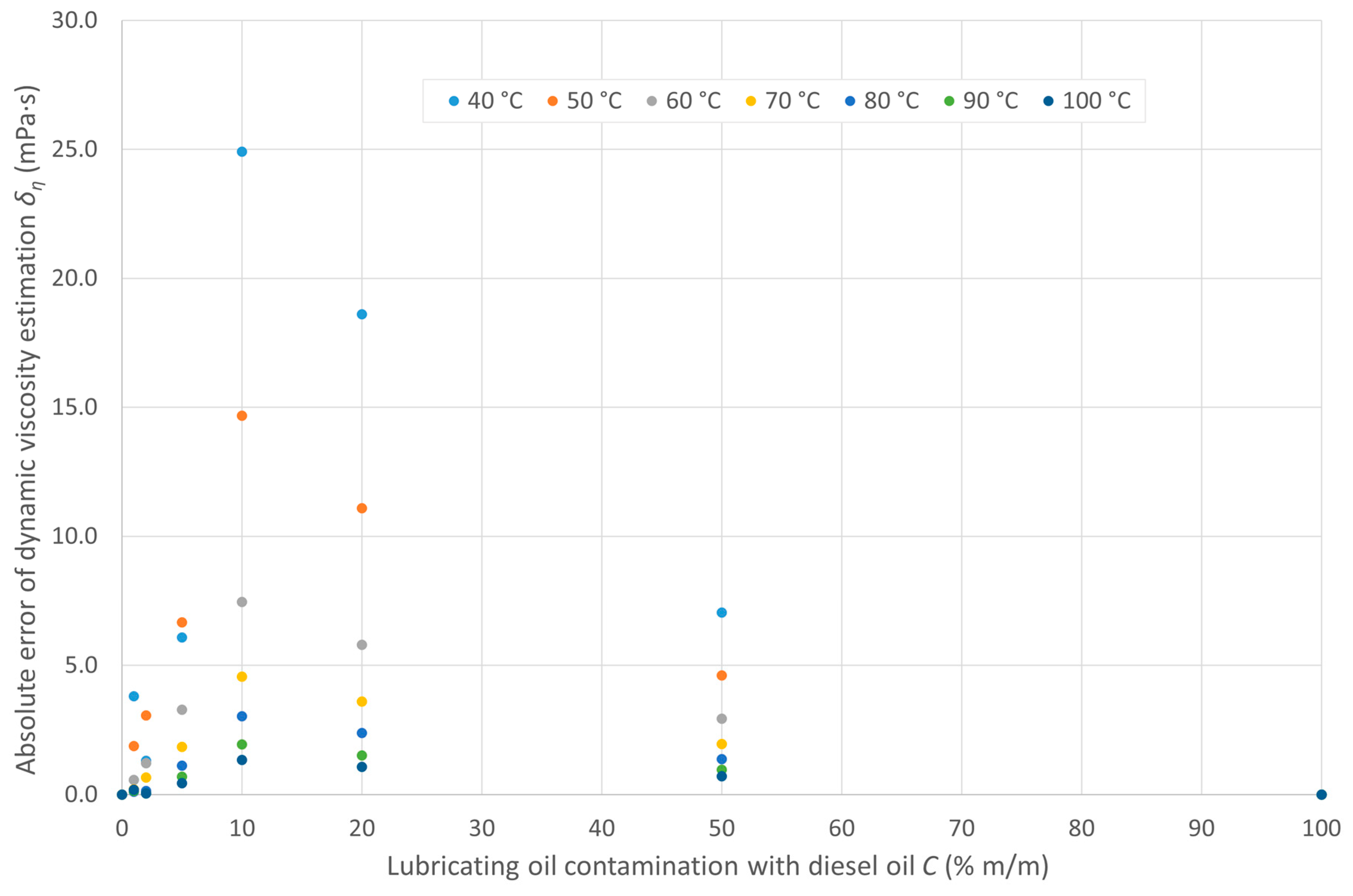
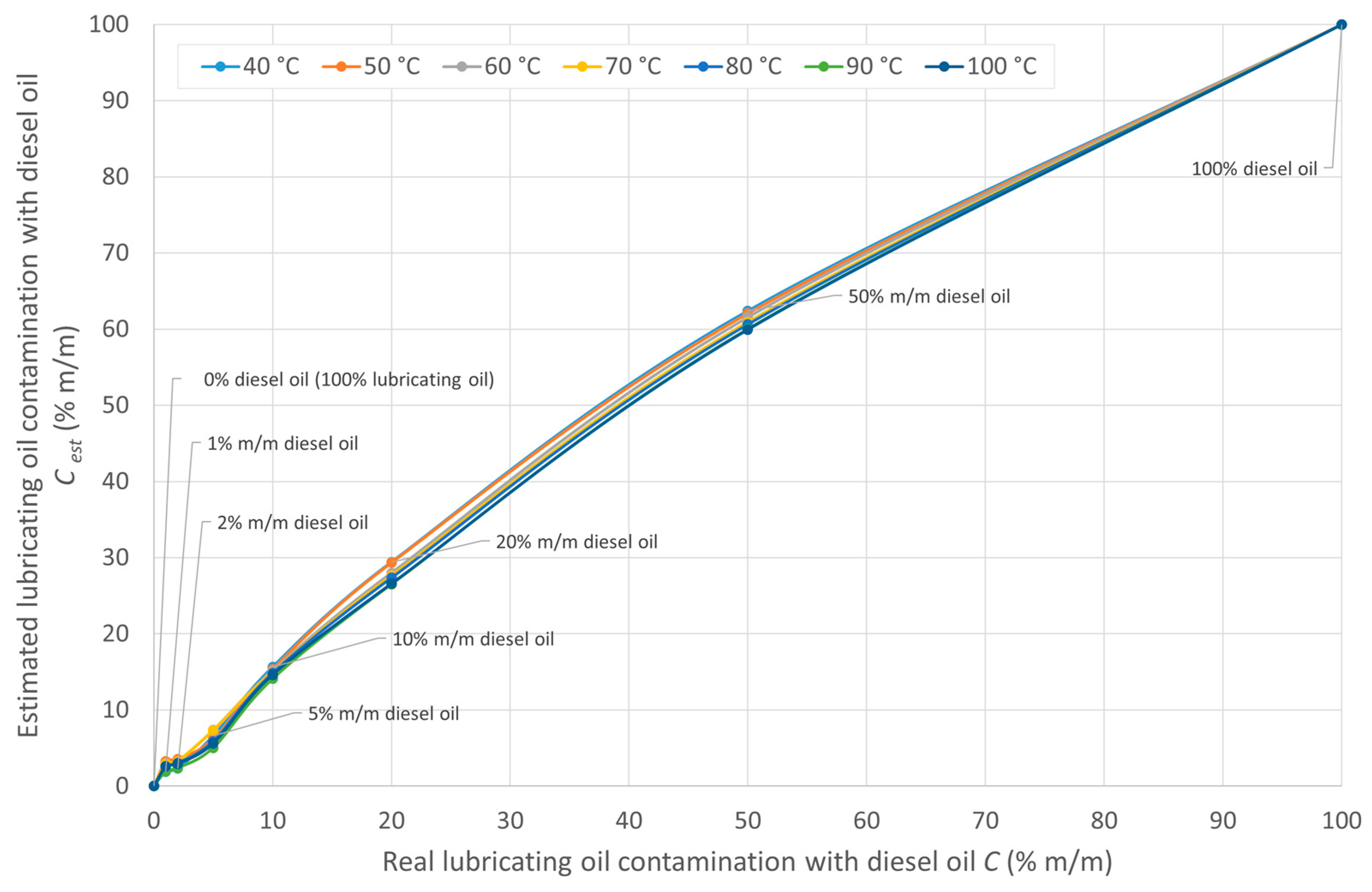
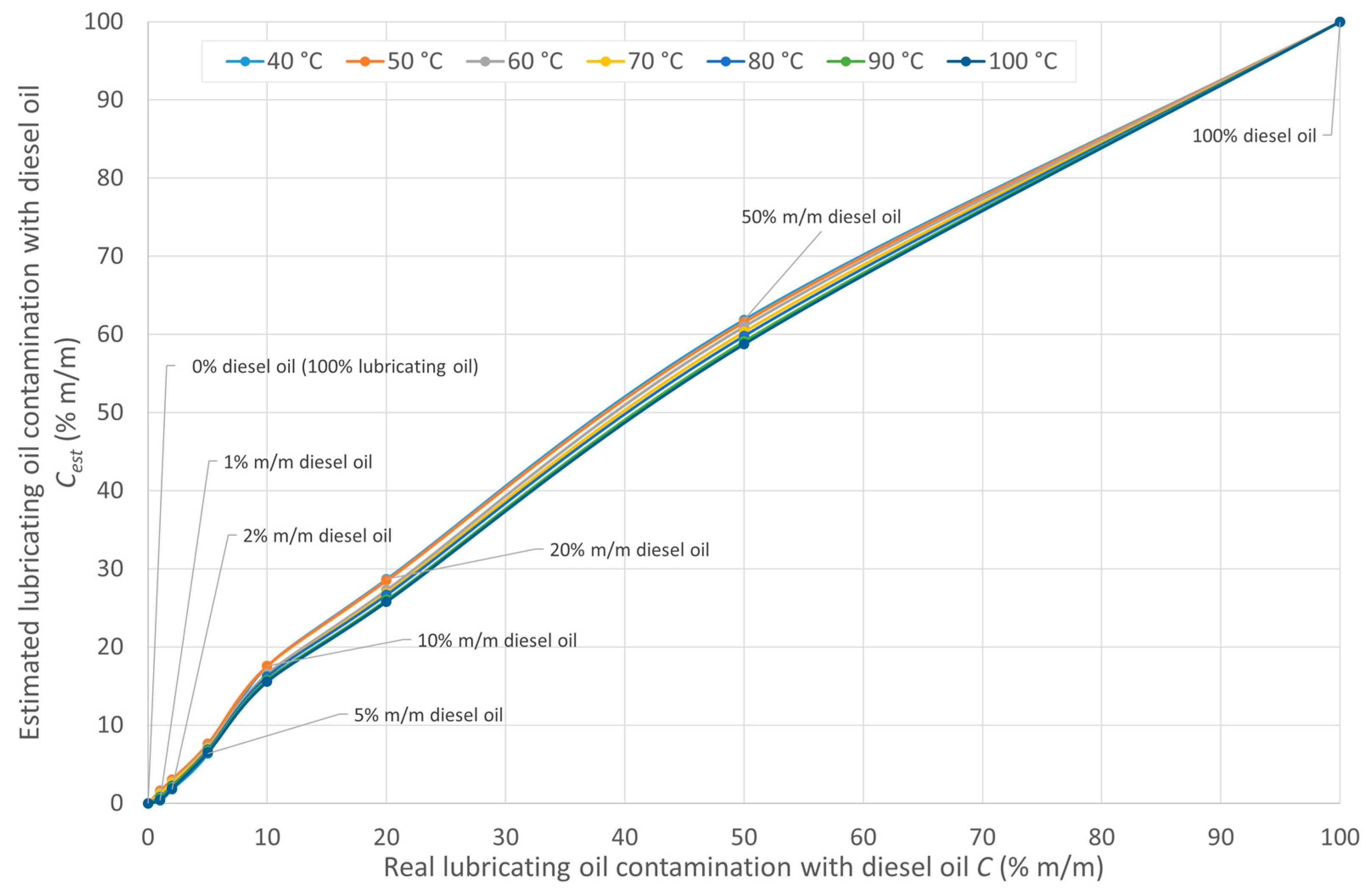
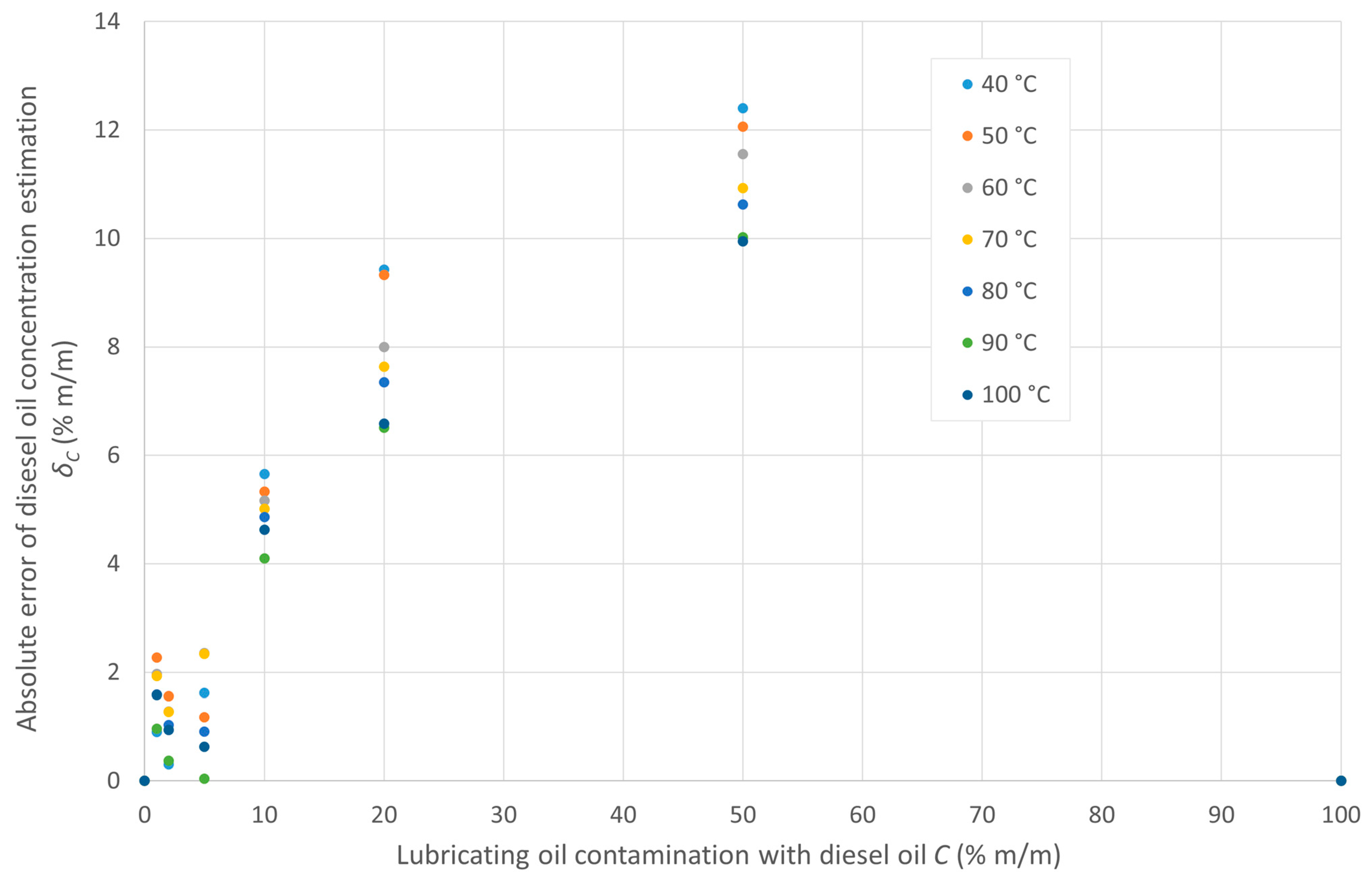
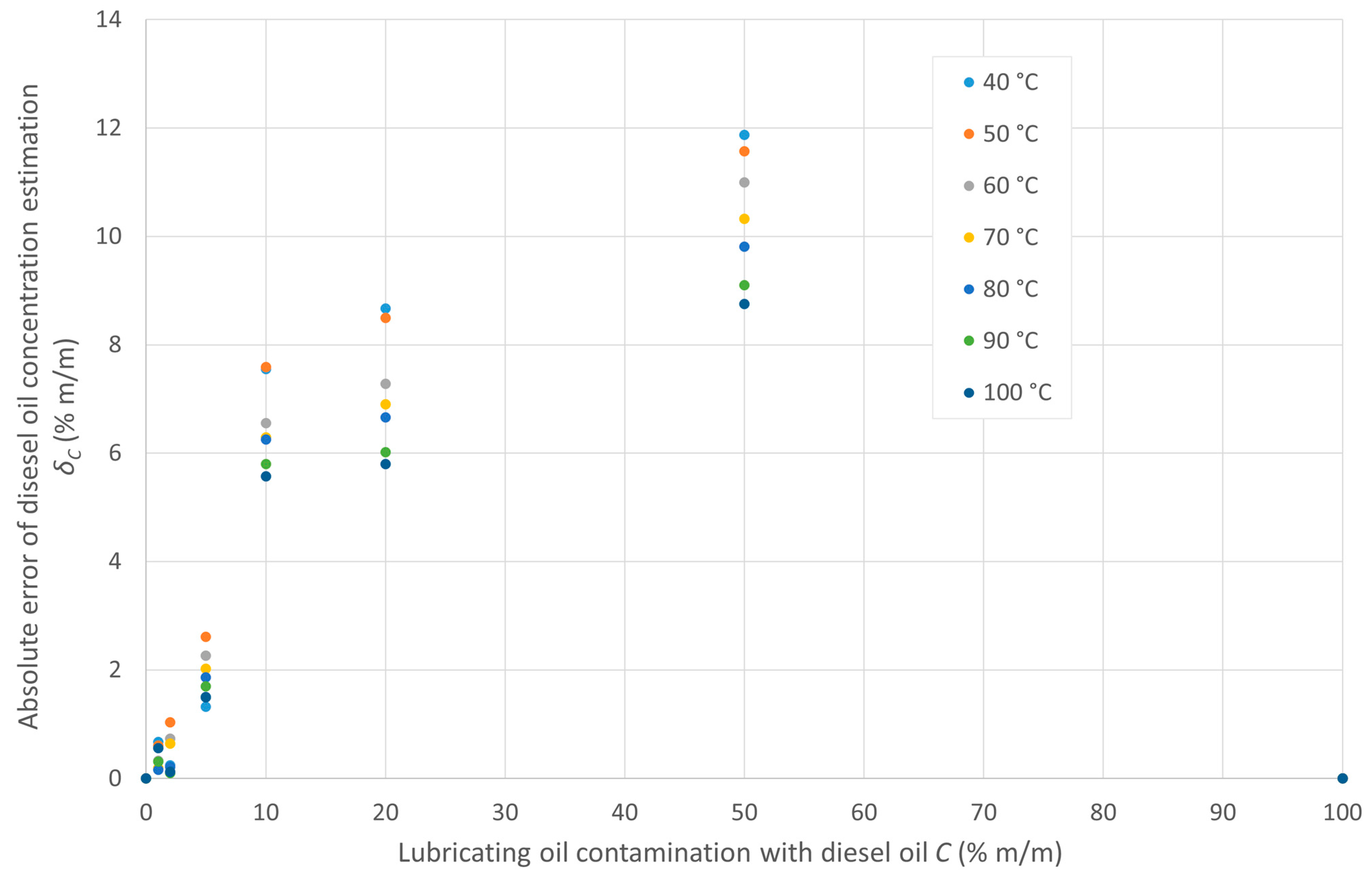
| Specification | Parameter | |
|---|---|---|
| Oil | SAE 30 CD/CF | SAE 40 CD/CF |
| Kinematic viscosity (according to PN-EN ISO 3104) [56] | 108 mm2/s at 40 °C 12.0 mm2/s at 100 °C | 160 mm2/s at 40 °C 15.7 mm2/s at 100 °C |
| Viscosity index [57] | 100 | 100 |
| Total base number | 12 mg KOH/g | 12 mg KOH/g |
| Flash point (marked in a closed cup) [58] | 225 °C | 235 °C |
| Pour point | −18 °C | −15 °C |
| Density | 895 kg/m3 at 15 °C | 900 kg/m3 at 15 °C |
| Specification | Parameter |
|---|---|
| Cetane number | ≥51 |
| Initial boiling point | 75–180 °C |
| Boiling point range | 95% vol. distills to 360 °C |
| Flash point (determined in a closed cup) | >56 °C |
| Auto-ignition temperature (according to DIN 51794:2003-05 [60]) | Approx. 240 °C |
| Kinematic viscosity (according to PN-EN ISO 3104 [56]) | 1.5–4.5 mm2/s (2.549 mm2/s) at 40 °C Approx. 2.151 mm2/s at 50 °C |
| Density | 820–845 kg/m3 at 15 °C |
| Relative vapor density | Approx. 6 (air = 1) |
| Cloud point | −7 °C |
| Cold filter lock temperature | −28 °C |
Disclaimer/Publisher’s Note: The statements, opinions and data contained in all publications are solely those of the individual author(s) and contributor(s) and not of MDPI and/or the editor(s). MDPI and/or the editor(s) disclaim responsibility for any injury to people or property resulting from any ideas, methods, instructions or products referred to in the content. |
© 2024 by the authors. Licensee MDPI, Basel, Switzerland. This article is an open access article distributed under the terms and conditions of the Creative Commons Attribution (CC BY) license (https://creativecommons.org/licenses/by/4.0/).
Share and Cite
Chybowski, L.; Szczepanek, M.; Gawdzińska, K. Arrhenius Equation for Calculating Viscosity in Assessing the Dilution Level of Lubricating Oil with Diesel Oil—A Case Study of SAE 30 and SAE 40 Grade Marine Lubricating Oils. Energies 2024, 17, 444. https://doi.org/10.3390/en17020444
Chybowski L, Szczepanek M, Gawdzińska K. Arrhenius Equation for Calculating Viscosity in Assessing the Dilution Level of Lubricating Oil with Diesel Oil—A Case Study of SAE 30 and SAE 40 Grade Marine Lubricating Oils. Energies. 2024; 17(2):444. https://doi.org/10.3390/en17020444
Chicago/Turabian StyleChybowski, Leszek, Marcin Szczepanek, and Katarzyna Gawdzińska. 2024. "Arrhenius Equation for Calculating Viscosity in Assessing the Dilution Level of Lubricating Oil with Diesel Oil—A Case Study of SAE 30 and SAE 40 Grade Marine Lubricating Oils" Energies 17, no. 2: 444. https://doi.org/10.3390/en17020444
APA StyleChybowski, L., Szczepanek, M., & Gawdzińska, K. (2024). Arrhenius Equation for Calculating Viscosity in Assessing the Dilution Level of Lubricating Oil with Diesel Oil—A Case Study of SAE 30 and SAE 40 Grade Marine Lubricating Oils. Energies, 17(2), 444. https://doi.org/10.3390/en17020444







